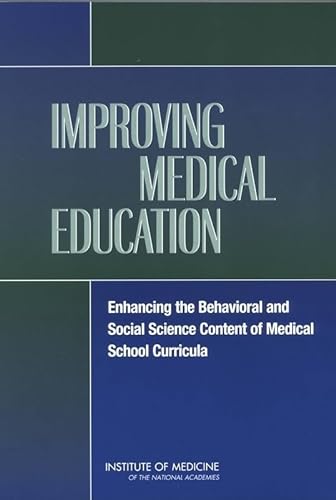Items related to Improving Medical Education: Enhancing the Behavioral...
Improving Medical Education: Enhancing the Behavioral and Social Science Content of Medical School Curricula - Softcover

Synopsis
Roughly half of all deaths in the United States are linked to behavioral and social factors. The leading causes of preventable death and disease in the United States are smoking, sedentary lifestyle, along with poor dietary habits, and alcohol consumption. To make measurable improvements in the health of Americans, physicians must be equipped with the knowledge and skills from the behavioral and social sciences needed to recognize, understand, and effectively respond to patients as individuals, not just to their symptoms. What are medical schools teaching students about the behavioral and social sciences?
In the report, the committee concluded that there is inadequate information available to sufficiently describe behavioral and social science curriculum content, teaching techniques, and assessment methodologies in U.S. medical schools and recommends development of a new national behavioral and social science database. The committee also recommended that the National Board of Medical Examiners ensure that the U.S. Medical Licensing Examination adequately cover the behavioral and social science subject matter recommended in this report.
Table of Contents- Front Matter
- Executive Summary
- 1 Introduction
- 2 Current Approaches to Incorporating the Behaviorial and Social Sciences into Medical School Curricula
- 3 The Behavioral and Social Sciences in Medical School Curricula
- 4 Strategies for Incorporating the Behavioral and Social Sciences into Medical School Curricula
- References
- Appendix A: Methods
- Appendix B: Committee and Staff Biographies
- Index
"synopsis" may belong to another edition of this title.
About the Author
Patricia A. Cuff, Neal Vanselow, Editors, Committee on Behavioral and Social Sciences in Medical School Curricula
"About this title" may belong to another edition of this title.
- PublisherNational Academies Press
- Publication date2004
- ISBN 10 030909142X
- ISBN 13 9780309091428
- BindingPaperback
- LanguageEnglish
- Number of pages168
- EditorVanselow Neal, Cuff Patricia A.
(No Available Copies)
Search Books: Create a WantCan't find the book you're looking for? We'll keep searching for you. If one of our booksellers adds it to AbeBooks, we'll let you know!
Create a Want